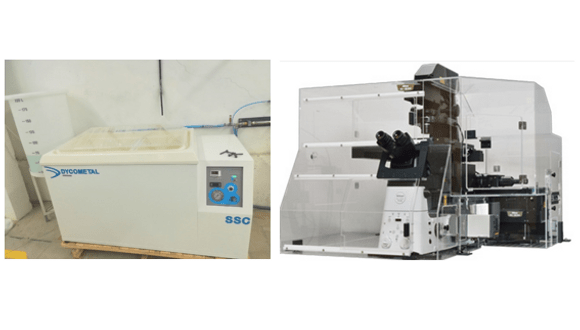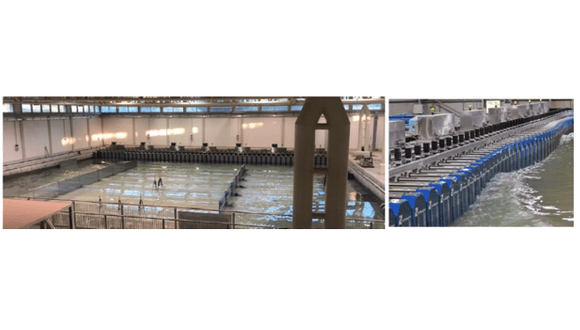Fri, 07 May, 2021
TWI is working alongside experts from seven EU nations on the MAREWIND Project to help meet European Union climate targets through the development of durable materials and recyclable solutions for the offshore wind sector.
Offshore wind turbines are often exposed to a variety of harsh conditions such as abrasion, bio-fouling, and corrosion. These conditions seriously damage the components of the wind turbines. Moreover, due to their constant exposure to marine moisture, splash and ice formations, and based on the location of the windmill plan, some of the turbines have suffer more severe damage. Overall, these conditions significantly decrease the lifespan of the wind turbines and limit the cost per MW.
 Figure 1. Damaged wind turbine components
Figure 1. Damaged wind turbine components
Tackling Abrasion and Corrosion
These problems gave birth to MAREWIND consortium - an EU funded-project that aims to resolve the major issues related to the short lifespan of wind turbines. Firstly, the project will aim to improve coatings that will prevent leading-edge erosion, marine biofouling, biofouling-induced corrosion and corrosion (both splash and atmospheric). In addition, the MAREWIND Project will optimise the concrete structures that go underneath the water’s surface. It will also improve wind turbine blade performance (as the blades must show good mechanical properties).
Technical Progress
In December 2020, the MAREWIND Project began by creating a framework of requirements, references and a background of the parameters for each task (coatings duration, leading-edge protections, water resistance of the concrete developed). Next, the consortium prepared a specific plan of technical activities for the rest of the project (characterisations to be carried out, lab-scale tests, scale up processes, etc.).
 Figure 2. Saline mist chamber (Lurederra) and AFM (INL) are some relevant equipment selected for the characterisations, specifically for the protective coatings
Figure 2. Saline mist chamber (Lurederra) and AFM (INL) are some relevant equipment selected for the characterisations, specifically for the protective coatings
In addition, the project consortium defined technical requirements for each different project section. It carried out a comparison with the current systems under use and an analysis of costs and target costs for every technology to be developed. The different characterisations that will be performed to ensure the good behaviour of the solutions achieved during this project have also been collected. Moreover, the acceptance criteria for most of this characterisation has been defined.
MAREWIND Demo Sites
During the MAREWIND Project, the project partners will develop technologies for anti-corrosion coatings for metallic parts and fastening elements, anti-fouling coatings, new composites for blades, anti-erosion coatings for the blades and new high-performance concrete materials. These technologies will be tested at different demonstration sites, as follows:
- The port of Leixões: The second busiest port in Portugal, representing 25% of all Portuguese international commercial trading. The port is located in the north of the country and it has 120 ha of water area. This is a possible site for the GBS prototype.
- Aguçadoura offshore test site: Located in northern Portugal, where the WindFloat wind turbine is installed, among other projects. The installation site is located 6 km off from Aguçadoura beach and has a 50m water depth. This is also considered to be a possible site for the GBS prototype.
- EDF-operated offshore wind farms: Two farms are available at Blyth and Teesside in the United Kingdom. MAREWIND will be given access to the farms in order to test anti corrosion coatings on coupons in real environmental conditions.
- Eumer’s facilities: As CETMA partner, Eumer are part of the University of Salento, located at the Ecotekne Campus in Lecce. They use a multi-element wavemaker to perform physical model tests in a controlled environment and under operational and extreme conditions. Concrete project solutions that are to be developed will be tested in this site to evaluate the effect of the wave motion on the developed concrete structures.
- Other onshore wind farms: MAREWIND’s partner, KOSHKIL has selected several farms in northern Spain and one in Southern Spain. They are working with the property to reach an agreement to use them as demo sites. These demo sites have been selected in order to test the coastal corrosion of metallic towers and flanges, erosion and ice formation on blades and on other elements, such as anemometers.
 Figure 3. Eumer facilities, where tests on concrete structures will be carried out
Figure 3. Eumer facilities, where tests on concrete structures will be carried out
You can find out more about the MAREWIND Project by visiting the project website, here.
The MAREWIND Project has received funding from the European Union's Horizon 2020 research and innovation programme under grant agreement No 952960